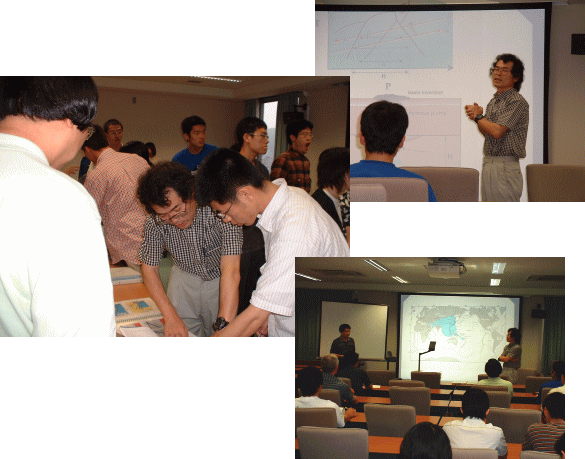
The triangular zone of Western Pacific from the Kurile through the eastern Himalaya to the Tonga islands, is characterized by (1)the double-sided subduction zones, by the Pacific from the east and by the Indo-Australian from the south, suggesting the largest amounts of water transported into mantle, (2) 600-700 m deeper ocean bottom than that of normal ocean basin at given age, suggesting lower-T than that of normal oceanic mantle, (3) common occurrence of augite phenocrysts in basalts in these oceanic basins, as reflected by higher water content and lower melting T in source mantle, and (4) abundant distribution of microplate in both eastern Asian continent and western Pacific ocean.
Moreover, this zone faces (5) a frontier to form a future supercontinent
which will be completed by collision and amalgamation firstly of Australia
at 50 m.y. after the present, followed by the collisions of N. and S. America
at 250 m.y. after the present. Presumably the underlying mantle at 410-660
km depth in this triangular zone is richest in water among the whole mantle
of the Earth, by the water transportation of double-sided subduction zones
and of the oldest oceanic plates. The fragmentation of Asian continent
and even in the formation of numbers of oceanic basins in the western Pacific
has been interpreted by the Indian collision and subsequent indentation
into Asia. This may not be the case, instead, the water in the underlying
mantle may explain all of these phenomena, i.e., water-weakening to break
the continental crust, decreasing mantle viscosity, and lowering melting
T of mantle to promote magmatic activity in spite of lowering mantle temperature
by subduction.
The storage of water in the mantle boundary layer (MBL) at 410-660 km with time would finally lead the continental breakup during or after the formation of supercontinent, say, 250 m.y. after the present. The sequential change of magmatic activity from kimberlite and/or carbonatite, through flood basalt to MORB, corresponding to continental breakup during the Jurassic to Cretaceous time and subsequent ocean formation, as well-documented by the Pangean breakup, may be caused by the fate of water in the MBL with time. The stored water in the hydrous wadslyite and ringwoodite underneath the center of supercontinent would become unstable by conductive heating from the underlying lower mantle with time, and finally decompose into dry phases to release free water which trigger the magmatisim and extensive mantle convection to initiate the continental breakup.
お問い合わせ先: irifune@dpc.ehime-u.ac.jp TEL 089-927-9645
詳細情報:http://www.ehime-u.ac.jp/~grc/
主催:愛媛大学地球深部ダイナミクス研究センター